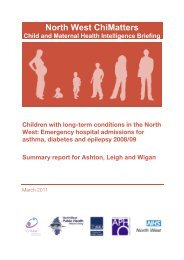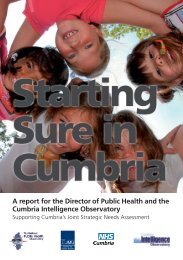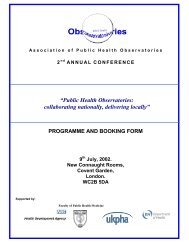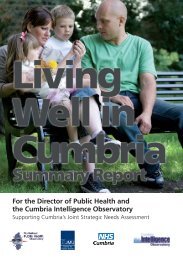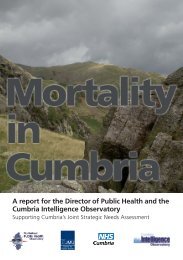9261 HEPATITIS C REPORT GALLEY - North West Public Health ...
9261 HEPATITIS C REPORT GALLEY - North West Public Health ...
9261 HEPATITIS C REPORT GALLEY - North West Public Health ...
You also want an ePaper? Increase the reach of your titles
YUMPU automatically turns print PDFs into web optimized ePapers that Google loves.
3. METHODS<br />
3.1 Subjects<br />
Study participants were recruited and laboratory analyses of samples undertaken<br />
between 1997 and 1999 for the Wirral sample and between 1998 and 1999 for the<br />
Manchester sample. The aims of the study necessitated drawing drug users from a<br />
wide variety of services as well as attracting groups of users not currently in contact<br />
with services. Consequently, subjects were either in contact with treatment agencies in<br />
Drugs <strong>North</strong> <strong>West</strong> and Wirral Drugs Service or not in contact with any drugs services.<br />
There were 110 people recruited through community drug teams, 112 from syringe<br />
exchange schemes and 23 through outreach. Forty five people were recruited on their<br />
first ever visit to a drugs agency, and 60, who were not in contact with treatment<br />
agencies, were recruited via a snowballing technique through the existing service<br />
users. Forty eight people presented at Wirral Drugs service specifically to request either<br />
an HIV, hepatitis B or C test and were invited to join the study (referred to as 'self<br />
presenters'). Nine further drug users were recruited through other sources (for<br />
example, some were resident in an in-patient facility).<br />
3.2 Questionnaire<br />
Subjects completed a questionnaire ascertaining drug taking, sharing of needles and<br />
other equipment, previous hepatitis B and C test history and sexual behaviour. Drug<br />
taking history elicited information on whether the subject had ever used or injected<br />
each of 14 named drugs, and whether they had used or injected these same drugs in<br />
the previous four weeks. Participants were also given the opportunity to identify any<br />
drug other than those on the list that they had used or injected. Sharing questions<br />
identified whether the subject had ever, or in the previous four weeks, shared needles,<br />
spoons, syringes, filters or other injecting equipment (such as water used in the<br />
preparation of drugs). The age of first use of drugs, the age of first injecting behaviour<br />
and the size of the group of fellow users on the previous occasion that the subject had<br />
injected was determined. Subjects were also asked if they had ever been to prison, and<br />
if so, on how many occasions. Sexual behaviour questions determined how many male<br />
and female partners the subjects had ever had, and had in the previous four weeks,<br />
and what their usual method of contraception had been. Questions on previous test<br />
history asked whether subjects had ever taken tests for hepatitis C or hepatitis B, and<br />
if so, what their results had been.<br />
Questionnaires were self-administered, but a drug worker was present if any clarification<br />
of questions was needed. Participants had a choice of named or anonymous participation.<br />
Those who were named were notified of their test result and consequently formed part of<br />
a cohort for follow up (see Aim 6). Two hundred and fifty nine (64%) volunteered to be<br />
part of the follow up group and therefore provided identifying details.<br />
H EPATITIS C IN INJECTING DRUG USERS IN THE N ORTH W EST<br />
17



